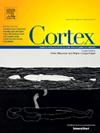视觉和听觉的感官都是在嗅觉皮层处理的,独立于气味关联
IF 3.3
2区 心理学
Q1 BEHAVIORAL SCIENCES
引用次数: 0
摘要
初级感觉皮层已被证明处理来自非首选感觉模式的感觉输入,例如,初级视觉皮层对听觉刺激的反应,使其假定的感觉特异性受到质疑。这是否反映了非偏好刺激本身的加工或源于跨模态关联是有争议的。视觉/听觉对象通常具有很强的相互关联;因此,很难用这些方式来解决这个问题。在这里,我们分离了两种相互竞争的假设,即初级皮层的这种形式的激活是由单感觉处理还是跨模态关联引起的,通过转向嗅觉系统,其中跨模态关联通常较弱。通过使用气味关联从无到强烈的无感觉视觉和听觉对象,我们发现处理气味对象的后梨状皮质被物体的声音和图像激活。关键的是,这种激活是独立于物体的气味关联的,因此证明了这种活动不是由于跨模态关联。使用Floyd-Warshall算法,我们进一步表明杏仁核在后梨状皮质和听觉和视觉面向对象皮质之间介导条件相关信息。重要的是,我们重复了过去在视觉和听觉系统中清晰的跨模态处理的发现。我们的研究表明,非嗅觉输入在嗅觉皮层的处理是独立于跨模态关联的,并有助于对嗅觉、听觉和视觉皮层的模态特异性有更细致的了解。本文章由计算机程序翻译,如有差异,请以英文原文为准。
Unisensory visual and auditory objects are processed in olfactory cortex, independently of odor association
Primary sensory cortices have been demonstrated to process sensory input from non-preferred sensory modalities, e.g., primary visual cortex reacting to auditory stimulation, bringing their presumed sensory specificity into question. Whether this reflects processing of the non-preferred stimulus per se or originates from cross-modal associations is debated. Visual/auditory objects typically have strong reciprocal associations; hence, it is difficult to address this question in these modalities. Here, we dissociate between the two competing hypotheses of whether this form of activation in primary cortices is caused by unisensory processing or cross-modal associations by turning to the olfactory system where cross-modal associations are generally weaker. Using unisensory visual and auditory objects with odor associations ranging from none to strong, we show that the posterior piriform cortex, an area known to process odor objects, is activated by both sounds and pictures of objects. Critically, this activation is independent of the objects' odor associations, thereby demonstrating that the activity is not due to cross-modal associations. Using a Floyd–Warshall algorithm, we further show that the amygdala mediate condition-relevant information between the posterior piriform cortex and both the auditory and visual object-oriented cortices. Importantly, we replicate past findings of clear crossmodal processing in the visual and auditory systems. Our study demonstrates processing of non-olfactory input in olfactory cortices that is independent of cross-modal associations and contributes to a more nuanced view of modality specificity in olfactory, auditory, and visual cortices.
求助全文
通过发布文献求助,成功后即可免费获取论文全文。
去求助
来源期刊

Cortex
医学-行为科学
CiteScore
7.00
自引率
5.60%
发文量
250
审稿时长
74 days
期刊介绍:
CORTEX is an international journal devoted to the study of cognition and of the relationship between the nervous system and mental processes, particularly as these are reflected in the behaviour of patients with acquired brain lesions, normal volunteers, children with typical and atypical development, and in the activation of brain regions and systems as recorded by functional neuroimaging techniques. It was founded in 1964 by Ennio De Renzi.
 求助内容:
求助内容: 应助结果提醒方式:
应助结果提醒方式:


